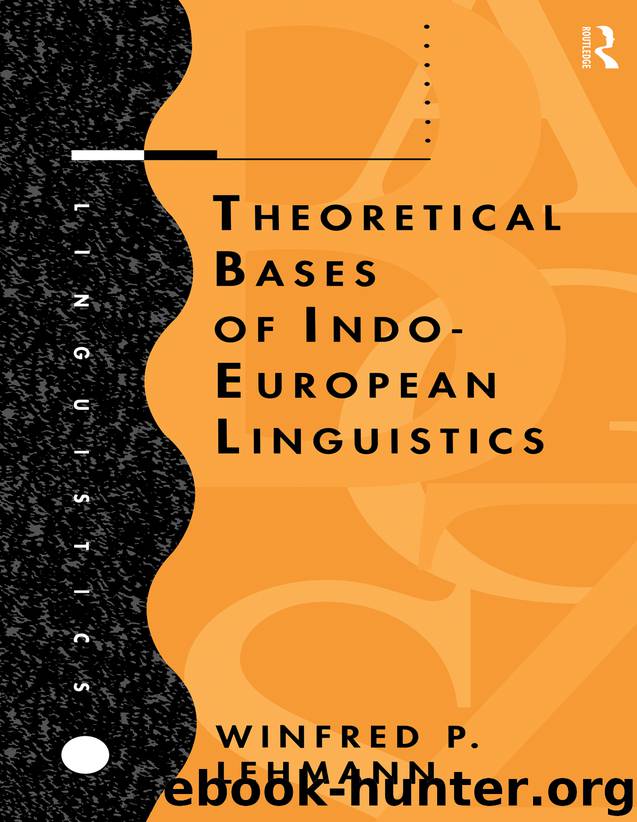Theoretical Bases of Indo-European Linguistics by Winfred P. Lehmann;

Author:Winfred P. Lehmann; [Winfred P. Lehmann]
Language: eng
Format: epub
ISBN: 9781136926907
Publisher: Taylor & Francis (CAM)
The form of the infinitive in Sanskrit has a different suffix from that of the infinitive in Greek (ein), or in Latin (vowel + re), or in Germanic (*onom > an > en > 0). The different suffixes indicate that the infinitive was added after the time of the proto-language.
Before examining the derivational morphology of the Indo-European verb we may observe that the inflectional system as found in early Sanskrit resembles that of OV languages. The affixes, including those for person, are loosely attached to the root or base. A set of forms made from a given root is supplemented by secondary conjugations, much like the verbal system in Japanese. The forms found with any root cannot be predicted. And the forms that occur do not make up a conjugation, as do those in Latin and Classical Greek. By contrast, the roots, derivational affixes and inflectional affixes must be viewed as elements with which actual forms are produced; selections from them may be made but not in accordance with a fixed system.
In conclusion, we may state that the traditional presentation of the verb in Proto-Indo-European has relied heavily on verbal forms found in early Sanskrit, although the freedom of formation from roots that is found in Sanskrit has not been adequately observed.
The discovery of Hittite raised many questions about the assumption of a Sanskrit-like system for the proto-language. The questions arose because the Hittite verb has many fewer categories and many fewer forms, resembling the verb of Germanic much more closely than that of Sanskrit or Greek. After comparing the Hittite verb system with that of the other dialects, Szemerényi proposes a tentative Indo-European system of two voices: active and middle; four moods: indicative, subjunctive, optative, imperative; three to six tenses: present, aorist, perfect and possibly as well future, imperfect, pluperfect (1970 [1989]: 245). As we note below, Hittite provides no evidence for positing a subjunctive and an optative mood. Its tense system also fails to support some of the tenses listed by Szemerényi. After examining patterns of derivation, we will deal at length with the Proto-Indo-European verbal system.
Download
This site does not store any files on its server. We only index and link to content provided by other sites. Please contact the content providers to delete copyright contents if any and email us, we'll remove relevant links or contents immediately.
Cecilia; Or, Memoirs of an Heiress — Volume 1 by Fanny Burney(32043)
Cecilia; Or, Memoirs of an Heiress — Volume 3 by Fanny Burney(31447)
Cecilia; Or, Memoirs of an Heiress — Volume 2 by Fanny Burney(31398)
The Lost Art of Listening by Michael P. Nichols(7150)
We Need to Talk by Celeste Headlee(5406)
Asking the Right Questions: A Guide to Critical Thinking by M. Neil Browne & Stuart M. Keeley(5349)
On Writing A Memoir of the Craft by Stephen King(4655)
Dialogue by Robert McKee(4154)
Pre-Suasion: A Revolutionary Way to Influence and Persuade by Robert Cialdini(3967)
I Have Something to Say: Mastering the Art of Public Speaking in an Age of Disconnection by John Bowe(3774)
Elements of Style 2017 by Richard De A'Morelli(3233)
The Book of Human Emotions by Tiffany Watt Smith(3136)
Fluent Forever: How to Learn Any Language Fast and Never Forget It by Gabriel Wyner(2911)
Name Book, The: Over 10,000 Names--Their Meanings, Origins, and Spiritual Significance by Astoria Dorothy(2833)
Good Humor, Bad Taste: A Sociology of the Joke by Kuipers Giselinde(2821)
Why I Write by George Orwell(2771)
The Grammaring Guide to English Grammar with Exercises by Péter Simon(2644)
The Art Of Deception by Kevin Mitnick(2621)
Don't Sleep, There Are Snakes by Daniel L. Everett(2496)
